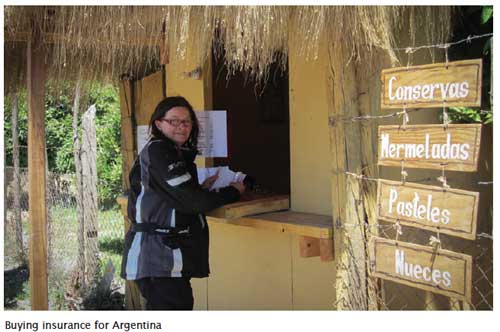
6 November – 11 December 2011
Shirley: At last, it’s time to hit the road. We did a shakedown ride yesterday and all went well. Now it’s time to head south. We board a ship to Antarctica next month so we’ve roughly five weeks to get to the most southernmost town in South America, the Argentinean town of Ushuaia, about 2,500 kilometres from here.
There’s a lot to see on the way and this will be the only chance we’ll have to explore this part of Argentina and Chile. We won’t take the most direct route south, rather we’ll head back and forth over the Andes, probably several times, so we can visit the lakes on both sides of the mountains and see the volcanoes and the glaciers. We want to get to Bariloche in Argentina and Pucon in Chile. We’ve heard the towns are great fun, the scenery incredible and the roads good for motorcycles. There’s a lot to cram in, but we think we can do it all.
In a couple of hours we’ll be in the Andes, taking our first ride over the mountains, through a mountain tunnel and down into Mendoza in Argentina. Everyone we know who’s ridden this road raves about it. Now it’s, finally, our turn.
I know Brian’s itching to get on the road. He’s been too long away from the bike.
•
On the road we pass a sign for Seguro, the insurance we need for Argentina and beyond, the document we’ll need to show at every border crossing. I scramble up a dirt embankment and cross over a disused rail line. It’s for sale in a thatch-roofed cottage where jams, marmalade and drinks are on display and insurance seems to be a sideline. With the help of the phrase book and my Spanish we decide on a five month policy for 126,000 pesos (about AUS $250) that will cover us for the Mercusor countries, the South American version of the European Union — Argentina, Brazil, Paraguay and Uruguay.
•
The road over the Andes doesn’t disappoint. Around every corner (and there are plenty of them) there’s a vista that takes our breath way. Brian is thriving on it and there’s no chatter between us. Brian is at one with the bike and I relax into the groove.
Brian: This magnificent piece of road is as I imagined it would be. The road surface is just about perfect. The bike’s handling the tight corners so well I forget that we’re fully loaded and would probably tip the scales about 500 kilos.
There’s snow on the peaks that tower above us as we take on the 50 or more switchback corners. Looking back down into the valley the trucks look like toys, slowly making their way up the Andes. It is truly amazing. As we head higher and higher the temperature drops from the mid 30°C down to a comfortable 21°C.
The Cristo Redentor Tunnel that takes us to the border between Chile and Argentina is 3,080 metres long. At the Los Andes Paseo Libertadores, the mountain pass, we’re more than three kilometres high, remarkable when you think Mt Kosciusko, Australia’s highest peak, is about 2,228 metres.
We ride through the tunnel and arrive at the Argentinean border post, Los Libertadores, which is a huge shed off to the side of the road. Inside, buses are lined up with passengers queuing and waiting to be processed. It doesn’t take long for us to get the passports stamped, but when we tell a young official that the bike is Australian he tells us to park, get our paperwork, including the carnet, and takes us to an office to get the papers signed. The two in the office laugh, saying that’s the only English he can speak. There isn’t a grumpy official in sight.
Once the carnet is stamped, they take our temporary Chilean import permit. After the trouble it took to get the bloody thing and they take it off us! Apparently we’ll need to get another one every time we come back to Chile.
That’s it. We’re officially in Argentina.
Shirley: The Andes are starting to flatten out on this side. There’s no snow, but the scenery is still spectacular. We encounter a lot of buses and trucks. Even though there’s no room for overtaking, they move over so we can sneak through or just indicate that the road ahead is clear. It’s getting late, after 2.00 pm, and we’re still about 190 kilometres from Mendoza.
Brian: We ride on and on. It’s hot and the roads are windy and clogged with slow traffic. It’s after six when we finally get to Mendoza and our tempers are a little frayed. We’ve had nothing to eat or drink since breakfast at the hotel and a cold drink half an hour after leaving Vina del Mar on the Pacific Coast. It’s been a long day in the saddle for our first day.
Cold showers soothe the tempers and a massive Argentinean steak with papas frita and ensalata mixta (it sounds exotic but it’s just chips and salad) is just the ticket. Top it off with a cerveza grande (large beer) for me and a local Malbec for Shirl and we’re human again.
•
For the next two days we explore the colonial city of Mendoza with its open spaces planned as safe havens for the citizens when earthquakes hit. Its vineyards make this one of the most famous wine regions in South America.
We taste the local wines and olives but it is a local liqueur that has me intrigued, absente, the local version of the once banned absinthe. Legend has it that Vincent van Gough was addicted to absinthe and I’m warned this is pretty lethal. I have to try it. It’s served the traditional way, in a shot glass. A minuscule amount of the startlingly green liqueur is dripped onto a small spoon of sugar and set alight. The burning sugar is dunked into the absente when it starts to turn to syrup. Then it’s down the hatch. The third sip is the best but my legs do start to tingle. I might need Shirl to help me get back on the bus!
•
Back at the hotel we sip on a glass of Malbec, a much more palatable drop than the absente, and check out the map. We have a real challenge ahead of us if we’re to fit in everything we want to do.
After Antarctica we plan to spend Christmas and New Year with our good friends Bernd and Heidi in Ushuaia. We met this young East German couple in Iran back in 2003. Despite an age difference of a couple of decades we’ve become incredibly close, drawn together by our mutual love of adventurous motorcycle travel. When the Berlin Wall fell Bernd was doing national service in the East German army. He decided to stay in the East and help rebuild his country. Today he and Heidi live in a tiny rural community and save like mad so they can get on their motorcycles and hit the road.
Leaving Ushuaia in January will give us just four months to get to Texas in May to meet friends from Australia for a police memorial ride. It’s really all about the weather. If we don’t make Texas in May we won’t get to Alaska in August when the weather is best for a road trip like ours. Any earlier and the mozzies will eat us alive. Any later and it’ll be too cold and the snow will block the roads.
To ride from the southernmost tip of South America to Alaska we need to hit both the top and the bottom of the world in summer — December in the south and August in the north. We can take eight months or 20, but we’d prefer not to take 20 months. We have children and grandchildren and great-nieces and nephews, a cat, a dog and a house all waiting for us at home.
It’s all about prioritising. We met people yesterday who told us about great things to see like San Pedro in the Atacama Desert, the falls at Iguazu, and Ché Guevara’s house near Cordoba. We decide the falls and San Pedro are goers, but we’ll have to miss out on Che. Cordoba is a long way out of our way to go to a museum, even if it is all about Che.
•
I’m a bit worried about the condition of Ruta 40 heading south. Locals tell me the 3,000 kilometres has huge stretches of gravel with some tarred sections. We’ll just take it as it comes, as we always do, one day at a time.
Shirley: Stress levels are high as we pack the bike. We still have way too much gear even though we posted some stuff home before we even picked up the bike. The same thing happened on our last trip. Some things never change. We’re probably at the maximum weight now and don’t want to overload the bike and break something.
•
We hit the road, taking the notorious Ruta 40 heading to San Rafael and then Malargue. I’m anxious about this part of the trip but the ride is brilliant and the countryside incredibly similar to Australia, its undulating hills covered in a type of salt bush, a yellow flowered plant that looks like a squat wattle. All along the road the Andes tower on the horizon.
Brian: Leaving San Rafael the vineyards give way to hills that turn into a small canyon with a road tracking through it that’s a bikers’ haven. Tight turns, good camber make this a dream road and I’m disappointed when we head out onto the arid plains, heading back towards the Andes.
The first few kilometres are okay, and then the wind picks up. It’s annoying at first, a cross wind pushing us around a bit, then it gets stronger and more blustery. The gusts are making me use the entire road just to stay on the tar. Even the passing trucks are struggling.
Where there’s no vegetation the dust being whipped up is biting and we’re literally getting sand blasted. Visibility gets down to 20 metres and I can’t see much at all until we eventually trickle into Malargue.
We’re covered from head to toe in a fine red grit and our necks and shoulders ache from the battering in the wind. A long hot shower and life’s not so bad, and after a cerveza and copa de vino we’re fine and dandy. Ah, the joys of motorcycle travel.
Shirley: After the gruelling day yesterday we start today with a plan. We’re going to make a dash for the border and cross the Andes again, heading back to Chile to visit the lakes district. The plan is to head south on Ruta 40 to Bardas Blancas and then take the road over Paso Pehuenche, Ruta 115 to Chile. Sometimes things just don’t go to plan.
•
Ruta 40 begins well with sealed road before abruptly turning to gravel and then road works. It is a bastard of a ride. There are times we’re not sure if we’re on the right side of the road or the right diversion around gaping holes in the road. Then, as suddenly as it began, the gravel ends and we come around a sweeping bend to a bridge across a river. The signs are clear — right to Paso Pehuenche and the Republic of Chile.

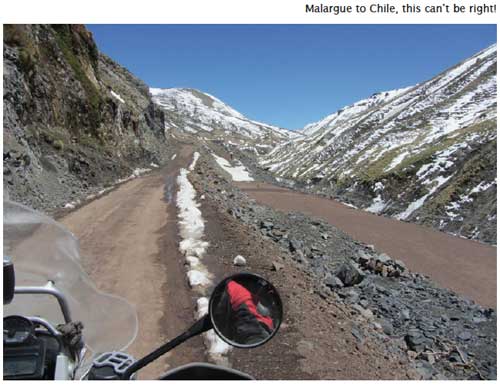
The road is sealed and magnificent and we pass through beautiful valleys with small farms, mudbrick houses and rolling pastures as we dodge horses and goats, the ever-present Andes high above us.
Then we come around a corner at a fair rate of knots and the sealed road just stops — just like that. No sign, and no road. The only parts of the road that aren’t thick gravel are the bridges over the deep gorges. The gravel quickly turns to mud where melting snow creates watercourses across a road that’s becoming more and more like a track. We push on but I’m getting a little concerned. There isn’t much traffic and absolutely nothing coming the other way.
We come to a town with a sign saying Aduana and Migraciones — Customs and Immigration. I check what could have been an official building at some time but which is now empty apart from a clothes line and an old motorcycle. Something about this just doesn’t seem right.
Brian: I keep going, the dirt road taking us high and higher into the mountains. The border post is meant to be at 2,500 metres. I have no idea how high we are, but we’re above the snowline and the road is deteriorating. I’m sure Shirl’s nervous, even though she’s not saying much. When the road becomes nothing more than a black dirt goat track I suggest we should turn around and head back. This is clearly not the way to Chile. I can feel Shirl’s relief as I gingerly turn the bike around and we begin the slow ride back. Going down the gravel is harder than coming up, with the front wheel losing grip.
Back at the main road we see a sign facing the up side of the road that says ‘no barro’ or something like that. Perhaps that means frontier is closed. Pity we didn’t see that on the way up.
•
We need to shake a leg to get to the next big town for the night. Chos Malal is 291 kilometres away and it’s 3.00 pm. This section of Ruta 40 is sealed, but it’s still a bitch of a road. It doesn’t take long for bitumen to turn to gravel. Apart from a few sections of sealed road its rutted and hard going. We’re bouncing around in the dirt and the dust. Ripio, the locals call it.
The dust is driving us insane, but we press on through trying circumstances made bearable by the amazing scenery of the Andes.
Shirley: I’m over it, but then, as if by magic, the road is sealed and we make really good time. I can tell Brian is enjoying himself for the first time in hours.
It’s after six by the time we get to Chos Malal. We see people queuing at the petrol station but don’t think anything of it. We’ll get fuel in the morning. What we need now is a room, a shower and a meal.
Tomorrow we’ll have another crack at getting to Chile.
Brian: As we were leaving Mendoza, a nice young man in our hotel told me that if I can ride Ruta 40 I should be in the Dakar Rally. I thought, ‘Yeah mate, in MY dreams’. The big beemer is doing a great job and handles really rough stuff and the tarred sections equally well. The all round ability of this bike, and it’s capacity to carry us two up and fully loaded is a testament to good engineering. I just hope it holds together. This is going to be a real test of man, woman and machine.
•
Before we can go anywhere we need fuel. We didn’t think anything of the queue at the petrol station last night. We should have.
The YPF petrol station has cones and little grates blocking access to the bowsers. They tell us they have no fuel and the tanker is not due until 5.00 pm. At the other fuel station in town the story is the same, except they think the tanker will arrive around midday.
Well, we can’t leave Chos Malal without fuel. The nearest town is 165 kilometres away and the gauge is telling us we have enough fuel to get about 140 kilometres. As the hours tick by without any sign of a fuel tanker we realise there’s nothing we can do but book a room and wait.
Shirl is in the doldrums. Strangely, I’m okay. We just go with it and plan a nice relaxing day doing bugger all and face it all tomorrow. My wonderful wife sees the common sense in that approach, eventually. We seem to be taking it in turns being up and down. Team Rix can tackle anything and in the end we will prevail.
Shirley: I spend a fair bit of time walking the streets of this desert town, meandering between the two petrol stations, ever hopeful that I’ll see the tanker arrive in town. Chos Malal is a strange place. There are plenty of shops and most of them seem to be selling shoes.
•
Around 8.00 pm we spot a queue at one petrol station. The locals seem to know the tanker’s arrival is imminent. By the time we get the bike in line it’s stretching two blocks.
We wait, and wait, and wait. We have a bit of fun with the locals, communicating with a mix of Spanglish and charades. A couple of families ask if they can put their children on the bike for a photo. This certainly breaks the boredom of standing in line and waiting.
At last, a bit after 9.30 pm, the tanker arrives. No one cheers, except us. This is obviously a regular occurrence here in the Argentinean desert.
The tanker driver jumps out of the truck and stops to say ‘hello’ to all the staff. He then takes his time to fill up the underground tanks. It is 11.00 pm before we are fuelled up and heading out to dinner.
Next morning, refreshed and fuelled up, we’re ready to take whatever Ruta 40 throws at us. The road from Chos Malal is sealed and good. Brian is having a blast taking the corners and I love the views. When we see the Andes we joke ‘Ho hum, here are the Andes again’, but it’s impossible to become blasé about this imposing sight.
At the Paso de Pino Hachado border post we’re back in the country of bureaucracy. We fill in a couple of forms, are issued with another permit to temporarily import the bike and cross into Chile. My very poor Spanish is tested when the quarantine officer wants to take our sheepskin seat covers. It takes a bit to make him understand they are Australian.
•
In Pucon, in Chile’s spectacular Lake District, the view is dominated by the magnificent volcano Vulcan Villarrica. The locals are used to living in the shadow of an active volcano and on the wall of the town hall is a bell that sounds when an eruption is imminent. I think I’d find this more than a little disconcerting.
Heading out for a drink we’re drawn to the German Beer Hall — Bier Garten — Cocina Alemana. It’s fate. Uli Witt, the owner, has a BMW GS and joins us for a beer. He has some great advice on good roads around the lake. He and his wife, Elke, run this restaurant seven months of the year and then go back to Europe or travel around for the five months of southern hemisphere winter. It seems like a pretty good life.
Brian: I can’t believe it when the new filling in my tooth falls out. The dentist in Valparaiso might be beautiful but she obviously isn’t much of a dentist. Now we find another dentist and manage to make ourselves understood. He warns us that the fix is only temporary and will need a more permanent repair when I get home. I don’t tell him we won’t be home for well over a year.
•
Bariloche, on the Argentinean side of the lakes, has been on our agenda for months yet everyone, including Uli, says we shouldn’t go there because of the eruption. We knew Puyehue-Cordón volcano erupted back in June, nearly six months ago, but had no idea the area was still covered in ash. Apparently high winds still whip it up and snowploughs are used to scoop the ash to the side of the road.
With these conversations in mind, there’s an eerie feel in Pucon today with a volcanic dust cloud hanging in the air, so far from Bariloche. The wind picks up a little, blowing away the volcanic dust and we see Volcan Villarrica is smoking.
•
From Pucon we continue riding south around more lakes and past snow-capped volcanoes. The scenery is remarkable. There are little farms with fat, contented cows, weekend hideaways and luxurious mansions — all against the backdrop of two great active volcanos, Osorno and Calbuco, and the huge Lago Llanquihue.
We make our way to Puerto Varas and try three hotels in town that all say they’re booked out. Shirl takes one on and asks if it’s because we’re on the motorcycle. No, there’s a doctors’ convention in town. Why is it that these conventions are held in picture perfect holiday locations? We find a nice little hotel with views of the lake and volcanoes and all is good.
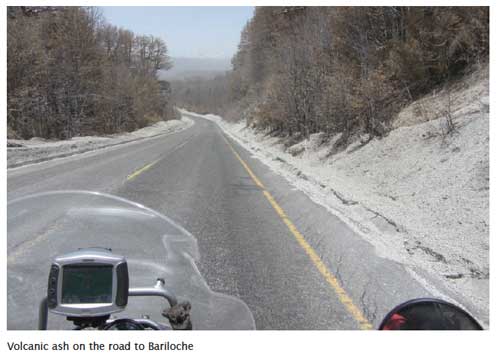
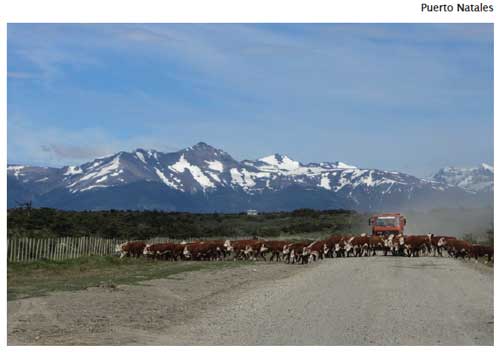
We have covered more than 400 kilometres again today, but it wasn’t a chore. This is undoubtedly one of our better days. And just to top off a near perfect day we have our first genuine asado, the local BBQ. It’s a great way to cook meat — on a wire grill suspended over an open fire. The fat cooks out slowly and the meat is mouth-wateringly delicious.
•
Even though we’ve been warned that Bariloche is beset by choking volcanic ash we still want to visit this lakeside town. This is going to be our only chance to see it. So ash or no ash, we’re going to cross the Andes again to get to Bariloche. As we start to climb up the eastern side of the mountains it looks overcast, but it’s not low cloud, it’s the volcanic ash cloud. It dusts us and the road. It’s so fine, it gets in everywhere.
The lakes are covered in it, great pools of ash gathering in little coves. The higher we get, we find the black jersey cows trying to graze on ground that’s covered in a dusting of ash. Still further up, the trees are dead, scorched from the heat of the eruption, their blackened trunks standing in fields of grey. The ash is piled up to 170 centimetres along the side of the road.
This is what we imagine Armageddon would look like.
Shirley: Bariloche is suffering under the weight of volcanic ash that has covered it for the better part of half a year. Clearly, businesses are struggling. Many hotels are closed. Restaurants and bars try to entice us in, keen for our patronage.
A slight wind change turns the air from clear to a wall of ash. The air is grey and it’s hard to breathe. The locals have had to survive long months of this discomfort.
Brian: We wander down to the foreshore and find a lovely cathedral made from local stone. As Shirl wanders around I sit in one of the pews and think about my dad. It’s two years since he passed away. He was a wonderful, gentle man who worked hard as a farmer all his life. I can’t help feeling he deserved better and a longer, richer existence. We shared some special moments alone and I’m sure he understood my desire to see and experience the world. Hopefully, he is riding with us.
•
Heading out of town we pass two motorcyclists on single cylinder 650 BMWs. We only plan to go as far as so-called hippie town El Bolson, about 150 kms away. When we get there we ride around but can’t find any interesting looking hostels or restaurants, nothing out of the ordinary, so we head further south to the end of the bitumen at Esquel.
Shirley: Carlos, the owner of our hotel, has plenty of tips and goes through the pros and cons with us. Argentina: boring with plenty of ripio. Chile: difficult but very beautiful. We decide to go to Chile, but not before the most spectacular breakfast that includes an apple flan with crème brûlée under the apple. While we wouldn’t ordinarily eat such sweet treats for breakfast we can’t resist. It is magnificent.
•
On Carlos’ advice we’re heading to La Junta in Chile where there’s a good hotel.
We come around a corner and bump into the two BMW 650s we saw yesterday and meet father and son, Tim and Klaus from Germany. We have a brief chat and tell them we’re heading to La Junta but they’re planning to go a bit further.
Brian: While the mountain scenery is amazing, the road is in very poor condition — much worse than the ripio of Ruta 40 in Argentina. We’ve been warned. It’s hard going. At La Junta we find the hotel Carlos recommended, Espacio Y Tiempo — Space and Time. It’s just as its name implies, set in beautiful grounds and a tranquil spot away from the shocking roads.
•
We head to the bar for a drink and discover Tim’s and Klaus’s bikes in the car park. They join us and we get talking about travel. Tim and Klaus are living Klaus’s dream of riding around South America. Tim has never ridden on gravel before today and says he isn’t very accomplished on the bike. He’s doing well in these trying conditions.
Overnight the rain tumbles down. It’s going to be a long, hard day as we continue south towards Chile Chico. We encounter road works a few hundred metres from the hotel. There are sections of slippery clay and others of deep gravel. I have to let Shirl off so I can get through one section without dropping the bike. It’s cold. It’s wet. And it’s difficult — very, very difficult.
Shirley: The clouds hanging around the mountains make for incredible views but the unrelenting rain it brings makes a difficult ride even more unpleasant. Millions of litres of waters rush down the cliff faces. The temperature hovers around 8.5°C most of the day. It’s bitterly cold.
I keep hoping, beyond hope, that we’ll go around a corner and find the paved road. But it doesn’t get better, in fact it gets worse. Reduced to a single lane, the road is rocky and steep as it winds its way higher and higher into the mountains.
I don’t want to complain because I know Brian is doing it harder than me, trying to wrestle the big, heavy bike around these sharp, blind corners. My gloves are wringing wet and my hands are frozen. My riding pants are wet through. I have cold feet. Brian tells me his riding pants are leaking and his hands are cold, even with the heated handgrips on.
Then we turn a corner and there it is — the sealed road. We’re both incredibly relieved. Even though it’s still pissing down, the road is smooth and that makes all the difference.
As we get to the town of Coyhaique the sun breaks through and we see the mountains in a new light. The sun is glistening on the snow and it is picture postcard perfect.
Brian: We’ve only done 285 kilometres today, with more than 100 on very tough ripio. Scrambling up wet rocky roads with a very steep incline in first gear, on a single vehicle track, two up and fully loaded is really hard on the bike. The clutch doesn’t seem to be holding up under the pressure and is starting to emit a strange smell. There’s a thin film of oil around the engine gearbox gasket, which is probably nothing to really worry about, but I know the clutch is working overtime. I’ll have to nurse it through. No point killing it only a month into the trip.
•
The terminal for the ferry to Chile Chico is just a car park with a ramp onto the open-deck ferry. A few cars roll up, then a small truck. Shirl is pacing up and down, worrying we won’t get on. Next small buses arrive and disgorge people, who unload their gear. There’s everything from disposable nappies to huge televisions and coffee machines. There are even kegs of beer and furniture.
Now I’m getting worried. Every one of the walk-on passengers gets on board, every bit of luggage, all the cars before, finally, we’re called on board. It’s a steep climb up the ramp and the only space is up against the rail near the bow. Two deck hands manhandle the bike sideways into a gap between the beer kegs.
Shirley: We’re getting very good at border crossings now and have no problems leaving Chile and entering Argentina again. Back on Ruta 40 the map shows the telltale black and white dashes of ripio. Great! Road signs show a tree being blown over to indicate it’s a wind danger area. The poplar trees along the roadside struggle in the harsh conditions.
Brian: We make it to Bajo Caracoles, a windswept desert speck which makes William Creek on the Oodnadatta Track in Australia look like a bustling town.
•
Last night the wind howled across the desert but just as dawn breaks there’s an eerie silence, as if Mother Nature is taking a break. Today will be tough so we want to hit the road early. Just as we’re getting dressed, the wind picks up again and keeps getting stronger. I soften the front suspension dampening, which will hopefully make the bike soak up the corrugations. I also let some air out of the tyres to allow them to grip a little more.
The wind is gusting and continually tries to push the bike into the loose stones. You get used to the front end skipping sideways. I try to pick my way through as best I can but get caught out every now and then. We pass a tip truck, its trailer blown over onto its roof. We take a break and rest behind the only poor excuse for a tree we’ve seen for over 250 kms, have a bite to eat and get back on the bike. Just standing in the wind is tiring so we might as well push on.
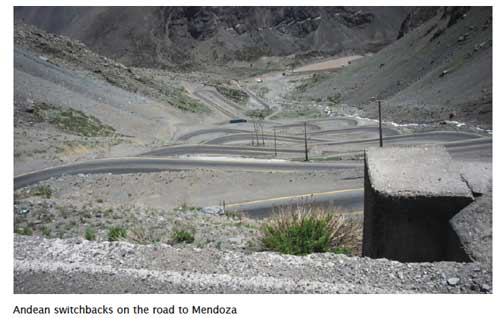
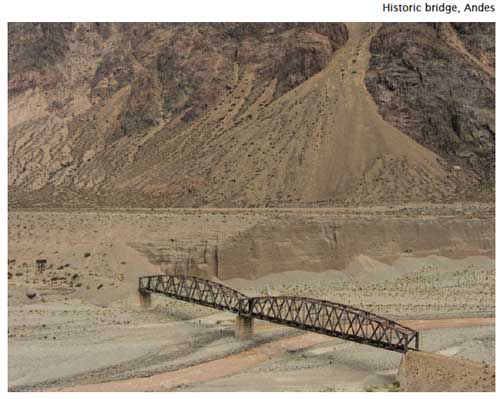
Shirley: We’re copping a pounding in the wind and need a break. The small settlement of Tres Lagos is where the ripio ends and the asphalt begins. Sheltering from the wind the bike starts to teeter on the side stand. Brian grabs it before it’s blown over. That’s how strong the wind is out here. We both feel very satisfied that we have conquered the great Ruta 40 without any major mishaps.
Brian: From El Calafete we visit the massive Glacier Perito Merino, about 80 kilometres from town. This is one of the sites we didn’t want to miss. The glacier is 35 kilometres long, five kilometres wide and 60 metres high.
We pay 200 pesos (about $50.00) to enter the national park. It’s wet and cold and just as I’m thinking 50 bucks is a lot to pay for a ride in this weather, we round a corner and there, floating along, is our first iceberg. Around a few more corners there’s a wayside stop and a viewing point offering a magnificent vista of the southern side of Glacier Perito Moreno — an ice wall being lapped by the icy cold waters of Lago Argentino. For two people from Melbourne, Australia, this is a spectacular sight.
In the stillness, away from the wind, the glacier sounds like a living creature. It creaks and groans as fragments crack, not only on its face, but also deep inside somewhere. We’re fortunate enough to see two ice calvings — huge chunks of glacier shearing off the face and crashing into the lake. It makes those hard days on Ruta 40 worth it.
At the car park we get talking to three young Italian men who ride bikes at home, and who are more than a little envious of our trip. As they get in their hire car to drive back to town, I can tell that Shirl is more than a little envious of them and the heater in their car.
We have a great ride back to town. I overtake a lumbering tourist bus and lift the front wheel, just a little — much to Shirl’s chagrin.
Shirley: A little or a lot, it’s all the same to me.
•
We love Glacier Perito Merino so much we have to see it from the water. Cruising on Lago Argentino the weather closes in — it’s cold, windy and raining a little. We regret the decision to leave our wet weather jackets at the hotel. We really need to get it into our heads that just because it’s November and we’re in the southern hemisphere we are a lot further south than at home and it can get bloody cold. There wouldn’t be icebergs and glaciers if it wasn’t cold, would there?
Perito Moreno is even more impressive from the water. It’s massive, towering over our boat. While we jostle for a spot on the deck an American comes up and asks if we are fans of Moto GP. We’re both wearing Phillip Island Moto GP beanies. We get chatting. Steve is a biker from Oregon and invites us to join him and his wife, Gayle, for a drink at their hotel. It’s a very pleasant way to end what has been a fantastic day.
Brian: A side trip to El Chalten means a back track of more than 200 kilometres past Tres Lagos. It’s a lovely town nestling under the towering twin rock peaks of the mountains they call Fitz Roy. There are serious hikers everywhere with their backpacks and sensible hiking boots. There are also very fashionable woman wearing platform hiking boots. Go figure.
Mt Fitz Roy is resplendent with its snowcaps etched against the piercingly blue sky. People have travelled here and stayed for days and never seen the Fitz Roy peaks because of the low cloud. We see it every day. We are blessed.
•
We have 12 days to get to Ushuaia for our trip to Antarctica. It’s lucky we allowed as much time as we have to explore the Patagonia area of Chile. There’s still a bit to see. Of course, this means yet another border crossing. Our passports are filling with stamps from these two countries.
Puerto Natales is an old fishing village that thrives on the tourists who come to explore the beautiful and rugged Parque Nacional Torres Del Paine. It’s also an area of prehistoric significance. It was here, at the Cueva del Mylodon, that the prehistoric mammal, the toothless mylodon lived until 10,000 years ago. We wander into the cave where there are no lights, no handrails and no guards. Can’t imagine that happening at a cave in Australia.
Shirl spies a toy mylodon in a café. Millie now lives in her pannier with Ken the koala, our mascot.
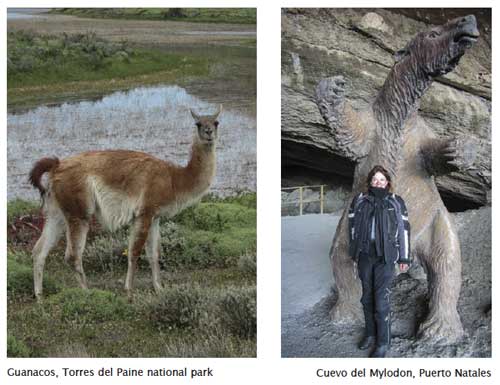
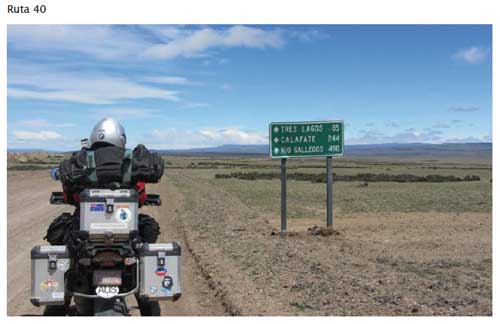
Shirley: We take a break at a restaurant surrounded by green pastures under the towering Torres Del Paine (Towers of Paine). This would be a magic place to camp, if we had camping gear. Brian doesn’t miss a chance to raise the fact we don’t.
Back on the road we get to Lago Pehoe where mountains reflect in the still waters. It’s hard to describe the colour of the water. Aquamarine doesn’t really express how deep and rich the colour is. Above us the condors soar — magnificent.
On the map it says we’re moving into an area where we’ll see wildlife. We don’t expect to see much as there are so many cars and buses on the road. Then we see our first guanaco, a member of the llama family. We’re rapt. When we see another we’re delighted. Then we see herds of them grazing on the side of the road and barely paying us any attention.
They look a little like kangaroos in the face — and are as cute as buttons. What we see is etched into our memories forever. Sometimes you can spend too long looking at things through the camera lens when you should just be looking with your eyes, your mind and your heart.
Back at the hotel we get talking to another guest about the beauty of Torres Del Paine. She says our souls are richer because of what we saw today. How right she is.
Brian: It’s a perfect day for the ride to Punta Arenas on the Straits of Magellan. The sun is shining and for once there’s no wind, not even a light breeze.
At dinner Shirl uses her best Spanish to order dinner. She orders tacos and gets a pizza. I guess her Spanish isn’t as good as it sounds to me.
Shirley: Ushuaia is the end of the road, literally. You can’t ride any further. Over the past weeks we’ve managed to see all the things we wanted to see. We’ve experienced the Andes, the desert, the glaciers, the lakes. We won’t be passing this way again.
We’re here for a couple of days before we sail out on the MS Expedition to Antarctica. It’s cold but beautiful with the Andes surrounding the town that sits on the Beagle Channel.
We need to find somewhere to leave the bike for the 12 days we’re on board the ship. We need to hire our Antarctica gear and we need to stock up on seasickness medication. We’ve been told crossing the Drake Passage can be much more than a little lumpy.
All chores accomplished.
Tomorrow night we’ll sleep on board and wake-up in the Drake Passage. Eek!